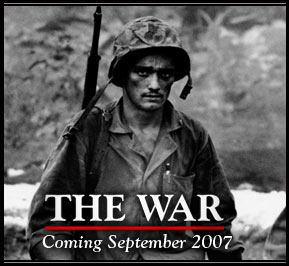 I’m looking forward to watching the new documentary by Ken Burns and Lynn Novick, “The War.” It’s a seven-part series that starts tonight at 7 p.m. on PBS. Watch it and maybe we can discuss it here on the blog. There’s a viewer’s guide (PDF) available, too, and here’s an excerpt about the first episode from that guide:
I’m looking forward to watching the new documentary by Ken Burns and Lynn Novick, “The War.” It’s a seven-part series that starts tonight at 7 p.m. on PBS. Watch it and maybe we can discuss it here on the blog. There’s a viewer’s guide (PDF) available, too, and here’s an excerpt about the first episode from that guide:
After a haunting overview of the Second World War, an epoch of killing that engulfed the world from 1939 to 1945 and cost at least 50 million lives, the inhabitants of four towns — Mobile, Alabama; Sacramento, California; Waterbury, Connecticut; and Luverne, Minnesota — recall their communities on the eve of the conflict. For them, and for most Americans finally beginning to recover from the Great Depression, the events overseas seem impossibly far away. But on December 7, 1941, their tranquil lives are shattered by the shock of the Japanese attack on Pearl Harbor, and America is thrust into the greatest cataclysm in history. Along with millions of other young men, Sid Phillips and Willie Rushton of Mobile, Ray Leopold of Waterbury, and Walter Thompson and Burnett Miller of Sacramento enter the armed forces and begin to train for war.
I watched Ken Burns and Lynn Novick answer questions about the film at the National Press Club (on C-SPAN), and it was very thought-provoking. Burns quoted a statistic that 40% of graduating high school seniors think the U.S. and Germany fought together against Russia in WWII. That’s really sad.
When I was going through school, I had some older teachers who were WWII veterans. I suppose the fact that they’re all retired now is part of the reason education on WWII is so impoverished today. In addition, if you are a retired veteran who wants to venture into another educational path, you might want to consider taking a look at these online colleges for military.
When I was in sixth grade at Rolling Acres School (it was K-8 back then), there were several of us boys who liked to play war. We would draw up battle plans on paper and then try to steal each others’ plans. My friend Jason decided he was going to be on the “bad guys” side and put swastikas all over his notebook. Keep in mind we were only 11 years old and, while we knew it wasn’t a good symbol, we had no idea the real gravity of what the symbol stood for (incidentally, I was on the “good guys” side). I never saw my teacher, Mr. Brunner, more agitated than when he saw Jason’s notebook one day. I don’t remember verbatim what he said (it was a long time ago), but a close paraphrase is, “You have no idea what you’re drawing. Do you know how many hundreds of thousands of men died to defeat the evil that that symbol represents? You will not show that symbol in my classroom again.” Even as a sixth-grader, I could tell this was a very heartfelt reaction from someone who had first-hand knowledge of how bad that enemy was. I’ve never forgotten it.
There aren’t many of those men and women with first-hand knowledge left, which is why this documentary was made — to capture their memories before they’re gone.
